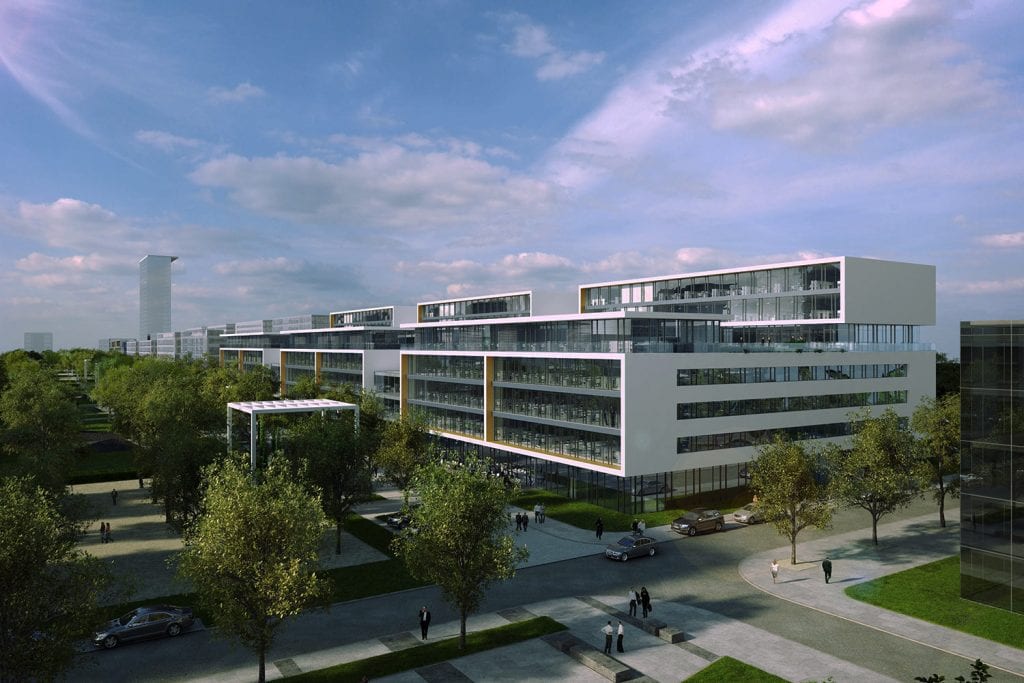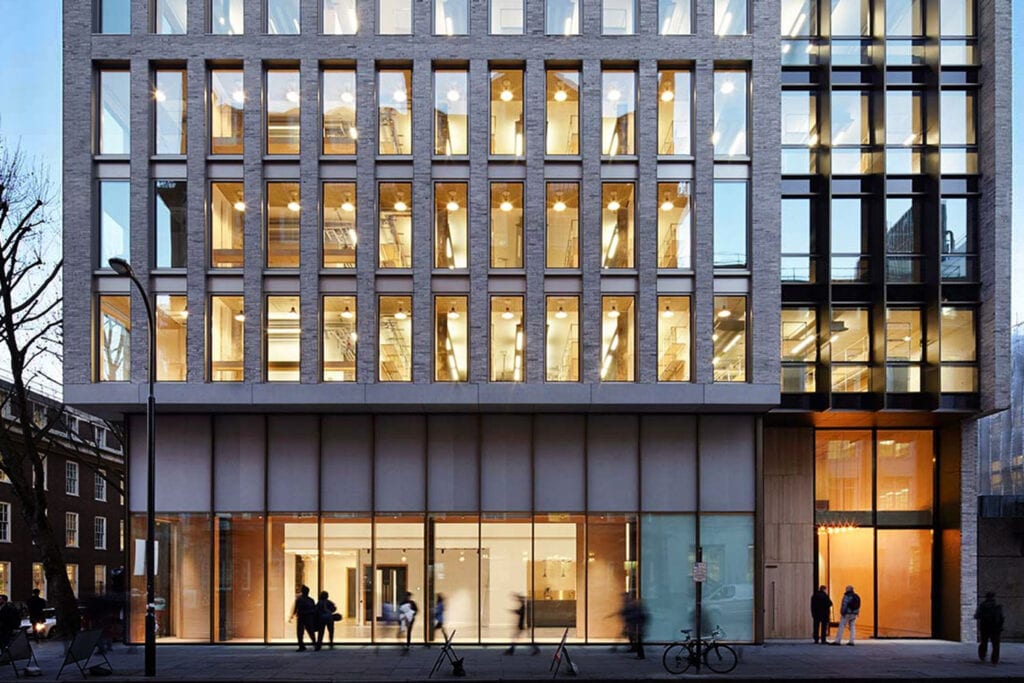Closing the material loop: circular construction
Buro Happold’s Urban C:lab Europe chapter invited two circular construction innovators from Berlin to learn more about the process. They explored how design within the AEC industry need to change in order to transition to circular construction.
This article summarises the event and highlights the key takeaways, namely the importance of building retrofit and refurbishment over demolition and new build construction.

Why we need to embrace circular construction
In Germany, 60% of waste comes from the construction and demolition industry (including road construction)1. Globally, the built environment accounts for approximately 39% of carbon emissions (28% operational emissions and 11% embodied carbon). To mitigate the effects of climate change, the AEC industry needs to drastically reduce carbon emissions.
The World Green Building Council (WGBC) has published a report stating that all new buildings, infrastructure and renovation will need to have a 40% reduction in embodied carbon by 2030 and be net zero carbon operationally by 2050.
Whilst the reduction of operational carbon has been addressed in European law since 2008, it is only just becoming a priority for legal authorities (i.e. with the EU Sustainable Finance Taxonomy Regulation2 and The London Plan 20213, which require lifecycle assessments for new buildings). And it is about time. Carbon emissions from building operations have reduced so much that around half the lifecycle emissions of a new, highly efficient buildings are emitted during construction4.
To reach climate goals, the reduction of embodied carbon is therefore paramount. Besides, considering alternative construction materials such as timber, avoiding unnecessary demolition and adopting a circular approach is part of the solution. Not only does this reduce emissions, but it also avoids material shortages (i.e., sand and gravel) and vulnerable supply chains.

Concular and Trnsfrm: two innovators within circular construction
Buro Happold has pledged to reduce the embodied carbon intensity of all new buildings, major retrofits and infrastructure projects by 50% by 2030.5 In addition to innovating our design processes to design buildings with lower embodied carbon using both third party software6 and developing our own parametric toolkits7), we are exchanging with and learning from other innovators in the AEC industry.
Urban C:lab Europe met with Concular, a PropTech start-up with a mission to make the construction sector carbon and resource neutral, and Trnsfrm, a radical design collective building a circular impact hub in Berlin.
Both start-ups are pursuing the same vision – to increase the reuse rate in order to lower waste and embodied carbon. Currently, only 1% of construction materials in Germany and Europe are being reused. The main culprit is the existing supply chain, which follows the “take, make, waste” model. Also, most designers are not used to the uncertainty and risk of designing with used materials.
We need to increase the reuse rate of construction materials
Concular facilitates the deconstruction, storage, operation and recertification of building products for use on other projects, while also calculating the financial savings and CO2 reduction in comparison to using new products.
This is possible through its software platform, which allows the digitisation of materials and components in existing buildings. The platform also offers a marketplace for these digitised materials. Once sold, it can either be moved from the old location to a new one, or temporarily stored until the new construction site is ready.
For example, in Germering, Germany, the company digitised the reusable materials of a shopping mall and have already sold 50% of the stock. Based on their current projects, they describe their value proposition with up to a 30% saving on deconstruction costs. This is achieved by:
- Salvaging components or materials from a relatively new building or interior fitout which is being demolished)
- Increasing the building value by 8% by selling parts before demolition
- Reducing the embodied carbon emissions of any reused parts by up to100%.
Trnsfrm create the reuse of materials directly on site
Trnsfrm is an expert building owner and building team, which allows full autonomy over decision making. They take on partial services for construction tasks where it is hard to find contractors interested and able to work with used materials.
Using Crclr house, Trnsfrm’s pathfinder refurbishment project, they experiment with their process of creative construction. Their approach leads to a high amount of problem solving on site, as well as efficient use of materials from the neighbouring construction site. Once completed, the project also has a positive social impact. Their ‘Impact Hub Berlin’ on the ground and first floor of their building provides a coworking space for circular activities and the top three floors provide affordable housing.
Trnsfrm works according to their “self-formulated” mantras. For example:
- Source materials and parts locally
- Pick recyclable materials
- Use common tools and open standards
- Avoid specialised equipment and approaches
- Simple solutions are easier to recirculate.

What is needed to drive change?
A construction industry in which an engineer might redesign the same building three times within their career is unsustainable. Legal frameworks and financial documents need to increase the disclosure of carbon emissions and internalise the costs of demolition, in order to make the reuse of building materials and retrofit more financially appealing.
Designing lower embodied carbon buildings, including designing for reuse and circular construction is not the easy option. The process requires more upfront design thinking and a significant reimagining of the construction logistics and supply chain. Therefore, circular construction requires developers who understand the value of this building model and want it to succeed on their projects. As engineers and architects, we can help demystify and safeguard this type of construction for clients who are willing to take the leap.
We need to standardise the calculation of embodied carbon emissions across different schemes, as well as encourage the disclosure of results and the underlying data (i.e., lifecycle stages and the scopes considered) in a way that can be easily shared and discussed by non-experts.
Technology solutions can unlock the reusability of parts at the beginning and end of a building’s lifecycle. Concular has successfully demonstrated the potential of using digital tools in sourcing materials from buildings which were not designed with reuse in mind and then matching them with new build construction.
It is clear that we should be designing all new build projects for disassembly and adaptability. Juliette Pignol from Trnsfrm spoke about how construction details need to account for the different lifespans of the individual components. This process ensures that parts with shorter lifespans can be replaced without compromising the whole building. Reversible connections and generic parts also increase reusability.8
New design hierarchies need to be accompanied by new tools like digital twins and material passports in order to track assets9, test methods and recertify processes, as well as innovate insurance policies.
Concular and Trnsfrm’s work has resonated within the practice and engaged a peer community of designers to apply the philosophy of material and component reuse to real projects which were designed mere decades ago.

Sources:
- https://www.umweltbundesamt.de/en/topics/waste-resources/waste-management
- https://eur-lex.europa.eu/legal-content/EN/TXT/?uri=celex:32020R085
- https://www.london.gov.uk/sites/default/files/the_london_plan_2021.pdf#page=35
- https://www.sciencedirect.com/science/article/abs/pii/S0378778813004143
- https://www.burohappold.com/wp-content/uploads/2021/10/buro-happold-gsr21-webfinal271021.pdf
- https://github.com/BHoM/LifeCycleAssessment_Toolkit
- https://bhom.xyz/
- ISO 20887:2020 guidance on design for design for disassembly and adaptability (DfD/A) and/or GXN’s Building a Circular Future
- https://www.bamb2020.eu/topics/materials-passports/











